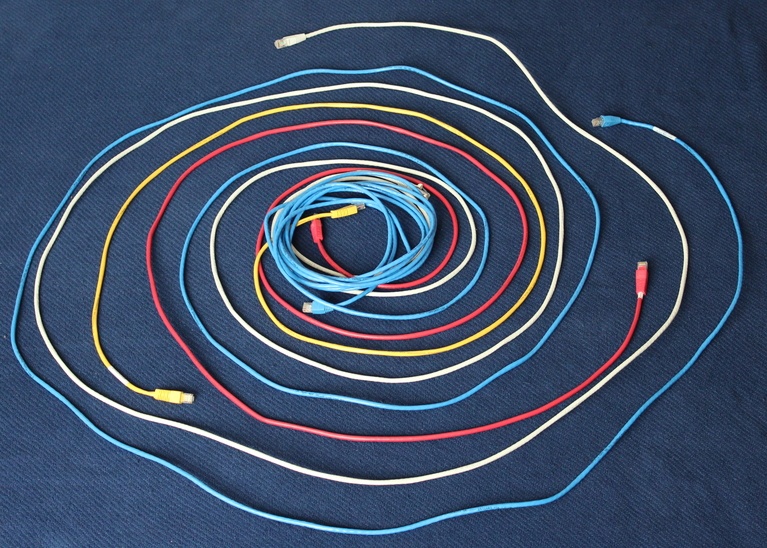
On Monday we launched a discussion about the similarities between hurricanes and networks, focusing on speed as the most prominent and revealing characteristic of each. While hurricane speeds are rated by several different categories, the Category of cabling used in your network can limit the network speeds you can achieve. But even when you think you have the right Category of cable in place to support higher speeds, there are three common reasons why your network may not be running at the speeds you expect.
In parts one and two of this series, we addressed the first two reasons why cabling may have down-graded your network speeds: Cheap Cables and Counterfeit Cables.
In this final installment, we will cover reason number three: Improper Terminations of your cabling.
Part 3 - Improperly Terminated / Installed Cabling
I can’t stress enough how important the physical cabling infrastructure is to any network. If you think of your network as a living entity, your servers are the brains, the router its mouth, the wireless access points its ears, the switches its heart, and all workstations and other peripheral equipment the extremities. The structured cabling system (SCS) is the central nervous system and backbone of your network that enables all those other parts to communicate with each other and with the outside world.
Despite the importance of cabling, IT Managers spend a disproportionate amount of time evaluating network hardware and servers, while investing very little thought into the cabling. This lopsided focus is partly due to the countless features and options available on the multitude of network hardware models and brands. But it also has to do with the common misconception that all cables are pretty much the same.
The two previous segments of this series showed how the less-expensive options that many IT Managers choose -- both Cheap Cabling and Counterfeit Cabling -- can not only slow your network down, but also create significant safety and liability issues. If those reasons haven't convinced you to start giving serious thought to your network cabling, then perhaps this will help.
Many IT Managers don't think about their cabling because it's not something they work with on a daily basis, like their servers, switches, PCs, and other active equipment connected to the network. It's the old Out of Sight, Out of Mind issue. To bring cabling back into the forefront of their thinking, it helps to consider how much longer you must live with your cabling purchasing decision as compared to all the other network components. Compare the average life expectancy of each component of your network:
- PCs & Printers - 3-5 years
- Switches & routers - 5-7 years
- Structured Cabling - 15-20 years
By investing in a top-quality, standards-based structured cabling system (SCS), you are building a body and backbone so versatile that, in five years when the limbs become weak and outdated, you can replace them with better parts - confident that your backbone will support them.
Conversely, by ignoring the importance of your SCS and choosing cheap cabling products and/or the lowest-priced cabling contractor, you are reducing the life expectancy of your structured cabling system. Since the cabling infrastructure represents a significant portion of your overall network investment - not just because of the cost of parts and labor to install cabling in the walls and ceilings, but also the disruption to your work environment when you need to re-wire your building(s) - it is critical to make sure you choose the right products and the right installation contractor.
The cabling installation contractor you choose is almost as important as the cabling products you have them install. That is because the process of terminating a cable is the single most common point of failure for even the most expensive cabling products, mainly because it is susceptible to human error.
According to Blue Jeans Cable, “the connectorization of the cable is a major issue: if there is too much untwisting, or other rearranging of the conductors in order to get into the connector, both crosstalk and return loss will suffer; likewise, if the connectors that are used are not up to snuff, they can cause all manner of trouble.”
So the question you must ask yourself boils down to this: Unless I babysit my contractor while they terminate every cable, how can I be sure they've done their job correctly? The answer is simple. Ask them for proof.
When you hire an installation contractor, they are agreeing to do exactly what you specify. If you think asking them to install, terminate and test every cable is enough, think again. You haven't said anything about what you expect them to do if a cable doesn't pass a certification test.
You will, however, gain assurances if you require your cabling contractor to perform the Testing and Certification of every cable according to the TIA 568 specifications, with all Test Results delivered to you upon completion. And to ensure that your new structured cabling system gets properly documented, you should also require the proper labeling of all cables, patch panel ports and workstation outlets according to the TIA/EIA-606 administrative standard.
If your scope of work includes vague instructions, then a Contractor can make general assumptions based on their interpretation of your wording. So you need to be as specific as possible. If you don't spell out exactly what you want, chances are you are going to get clobbered by numerous change orders once you realize that their interpretation of your requirements is different from yours. Believe it or not, some contractors thrive on low-bidding jobs with vague requirements just so they can win the contract and start piling on the change orders to increase their revenue.
In summary, when planning a new network or an upgrade to an existing one, it is critical for the IT Manager to invest as much thought and consideration in their cabling as they do with every other component. Cabling is a long-term investment that should be made only after careful consideration of your current and long-term needs. And your decision to use quality infrastructure products instead of Cheap or Counterfeit cabling is just as important as the contractor you hire to install it. Remember, in almost every situation, you will get exactly what you pay for. And if you opt for a cheap price, chances are you will get a cheap solution.
At Tech Service Today we are proud of our high quality cabling and network installation work that has earned us many happy clients. We'd love the opportunity to talk to you about how we can help you build and maintain a network that helps you finally realize the speed and reliability you have always dreamed about.
(Got a story of your own to share? We'd love to hear it. Email Tim Sauer at tim.sauer@techservicetoday.com)
Need help installing, troubleshooting, testing, documenting, or replacing your network cabling? Call Tech Service Today for on-site technical services anywhere in North America - often in 4-hours or less.
Just call (800) 973-2022 (option 1), or Email us at Service@TechServiceToday.com
